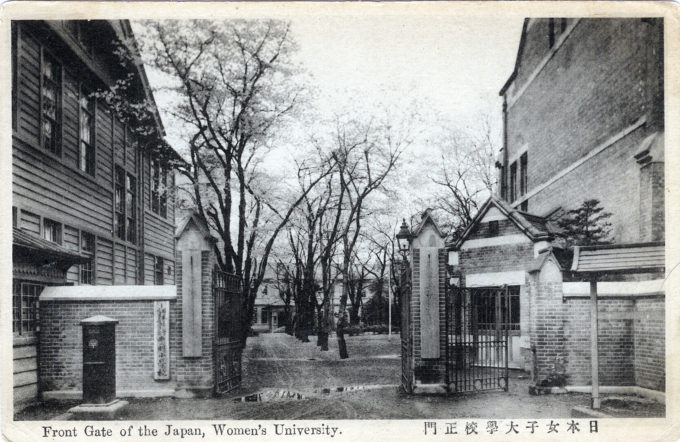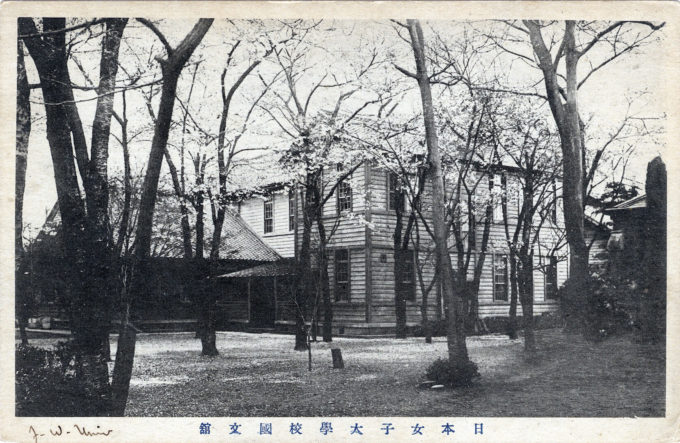
“Front gate of the Japan Women’s University”, Meijiro, Tokyo, c. 1920. Japan Women’s University [Nihon joshi daigaku] was founded by education reformist Jinzo Naruse in 1901. The school enjoyed the stalwart support of two leading benefactors: Eiichi Shibusawa, a Meiji era businessman called “the father of Japanese capitalism”, and Asako Hirooka, one of Japan’s earliest businesswomen and bankers (who was also the model of the main character of the NHK-TV series Asa ga Kita).
See also:
Hyogo Prefectural Girls’ School, Hyogo (Kobe), 10th Anniversary postcards, 1911.
Sendai Private High School for Girls (Sendai Koto Jo Gakko), Sendai, c. 1910.
“It may interest the readers of this paper to hear something of the first, and so far the only, women’s college in this country as distinct from mission schools. The enterprise was started less than two years ago, under the auspices of a few distinguished and wealthy men, who supported the President in his efforts to found a thoroughly modern college for the education of the women of this Eastern land.
“That it was needed is abundantly proved by the fact that already over eight hundred students are to be found within its walls, four hundred of whom belong to the college proper, while the others are pupils of the high school carried on in the same building and taught in part by the same staff as the college students.
“Of this number many come from the furthest parts of Japan, girls and women of all ages, from the youngest pupils of the high school (twelve years old) to students in the University classes of over thirty five years of age. Some have been teachers themselves for years, others are looking forward to a long career of usefulness as such, and many hope to visit England and study for a time at one of our Universities before returning to Japan to become lecturers and literary workers in their turn.
“The college is undenominational — all religions are tolerated, none is taught — and the staff comprises Christians, Shintoists, and Buddhists, while among the students the same variety exists. The whole number of lecturers is forty-one, including the President, and of these the majority are men and Japanese, one German lady, two English, and one American lady also being amongst them. The departments are three: English Language and Literature, Japanese and Chinese Language and Literature, and the Domestic Department, in which sewing, cooking, the tea ceremony, flower arrangement, and similar things are taught. Music and drill are also among the subjects studied, and very creditable progress in these is being made.
“… The dormitories, which are built on the opposite side of the gardens, are in pure Japanese style and accommodate altogether some three hundred boarders, each house of thirty students being under the care of a house matron, who is generally either a teacher or one of the older students. … She is responsible for those under her charge as to letter-writing, walks, visiting, and food. Rules are strict, no one being allowed out, except on Thursday and Sunday, on both of which days they must be back b 5 p.m.”
– The Journal of Education, February 1903
“A visit to this seat of advanced learning for Japanese young women is a delight and a revelation, for one sees hundreds of earnest students pursuing their tasks of many kinds, all with both purpose and pleasure.
“The grounds are splendidly situated, being elevated above the surroundings and commanding a view of the countryside for many miles; they are also so extensive, having been enlarged several times, that they now embrace kitchen gardens, which supply the twenty boarding houses, each having its special allotment for cultivation; hot-houses and flower gardens; a poultry yard and hennery, and a dairy and pasturage, all under the control and management of students of various courses, or the graduates’ association.”
– “Japan Women’s University”, The Japan Magazine, May 1911


